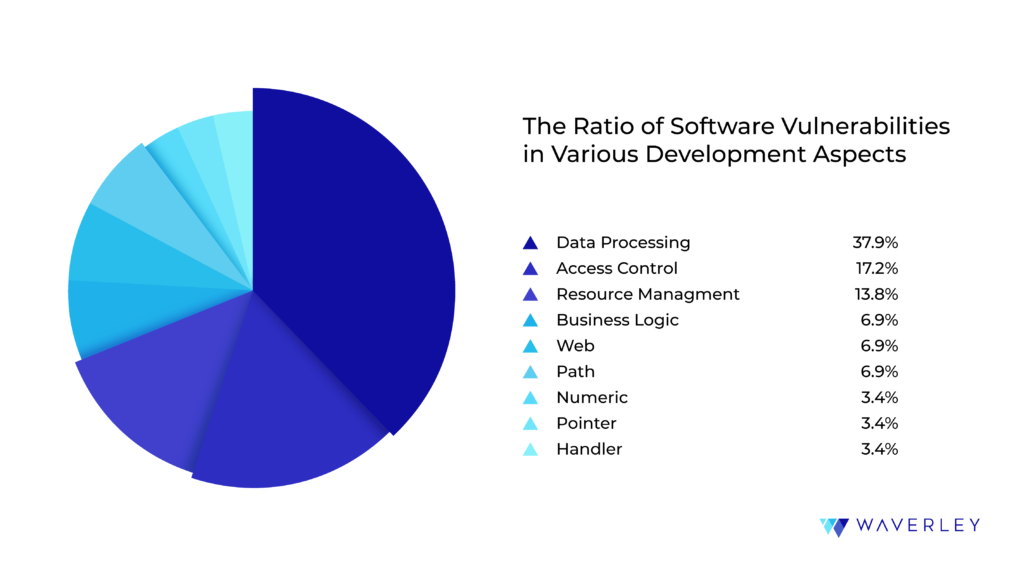How To Find Vulnerabilities In Code
Top 25 Coding Errors Leading to Software Vulnerabilities

Are you sure your software is safe from vulnerabilities? The most common software holes are also the most unsafe. They are caused by software flaws – configuration or coding errors that actually can be avoided or stock-still. To aid you lot ameliorate cyber security in your system, hither is a review of the most commonly occurring and exploited software weaknesses reported past MITRE (CWE Top 25 2019) and OWASP (OWASP Tiptop 10 2017).
Contents
- Collection and Rating Methodologies
- When in the SDLC Exercise Well-nigh Coding Errors Happen?
- The Most Vulnerable Programming Perspectives Revealed
- Data Processing Flaws
- Security and Access Command Weaknesses
- Resource Management Flaws
- Flaws in Business Logic
- Other Weaknesses
- How to Avoid Common Software Vulnerabilities and Exploits?
- References
Information technology is a well-known fact that about cyber security threats are caused by coding errors. Cyber security is an area of expertise for Waverley and nosotros are often asked to handle complex issues. The wide diverseness of problems we accost gives the states a wide perspective on what tin go wrong and where your organisation is susceptible to a security breach. Some of these vulnerabilities are more common than others. Both MITRE and OWASP take released lists of the most critical coding errors that result in security risks (in 2019 and 2017, respectively). Our cyber security teams at Waverley reference MITRE and OWASP when mitigating cyber security threats. However, our clients ofttimes don't understand where the coding errors are and what dangers they pose. In order to fill in this gap in agreement, we have summarized the critical weaknesses that pb to serious vulnerabilities in software, below. We'll besides explain how these weaknesses can exist exploited and how it can touch your business. Lastly, you'll discover how you can protect your systems and devices from cyber-attacks.
Collection and Rating Methodologies
MITRE and OWASP (Open up Web Application Security Project) have compiled lists of the well-nigh common coding errors that leave you vulnerable and result in serious security risks. The mission of both these non-profits is to reduce cybercrime past improving software security and finding solutions for technology issues. We'll focus here on the MITRE Mutual Weakness Enumeration (CWE) list of Top 25 in 2019 and the OWASP Tiptop 10 list in 2017. The initiative helps developers, quality assurance specialists, projection managers, researchers, and other people working in the industry and brings more cyber security awareness to the Information technology customs. The lists help usa discover and bargain finer with security vulnerabilities. Cyber security specialists at Waverley likewise turn to these lists when locating various types of software vulnerabilities and coping with them.
The CWE and OWASP coding errors lists consist of mistakes observed in the real-world programming do. The lists were compiled through surveys and personal interviews with members of the IT community. They identified a list of weaknesses that tin occur at whatsoever stage of the organization development life wheel. Mistakes can happen during design and architecture as well as during implementation and operation. Flaws tin also occur across different programming languages and computer system components, which can result in various types of vulnerabilities.
In the CWE Top 25 2019 list, MITRE evaluates software weaknesses and scores them on their rating scale. The factors they use are:
- the coding flaw occurrence frequency
- the subsequent vulnerability exploitation severity
Once more, these figures come from public reports.
Meanwhile, the OWASP Height ten 2017 list of security risks focuses on web application development procedures. The arrangement evaluates the types of software weaknesses with a different approach. They look at the exploitability, prevalence, detectability, and technical impact factors:

In our example, we tried to observe out when most of the coding errors and security vulnerabilities accept identify. Nosotros've grouped these coding errors according to the programming categories where they appear.
When in the SDLC Practise Most Coding Errors Happen?
In the course of our analysis of the MITRE and OWASP weaknesses lists, we discovered an interesting fact. Certain calculating concept areas are more decumbent to diverse types of software vulnerabilities. This is due to a college amount and frequency of potentially dangerous and frequently exploited faults. The pie-chart below represents the percentage of computer system aspects well-nigh likely to accept vulnerabilities in terms of cyber security.

The Nearly Vulnerable Programming Perspectives Revealed
Data Processing Flaws
Buffer Overflow. Following the ranking, nosotros tin make an observation. The majority of coding errors (37.ix%) occur in the information processing aspect. This puts your cyber security at high risk. The software weakness commonly known equally "buffer overflow" is ranked #one on the CWE Top 25 2019 list and is most prevalent in C and C++ programming languages. The same is truthful of its close allies Out-of-bounds Read and Out-of-premises Write. These failures happen when the memory buffer is fix to receive more than information than its capacity permits. Then, in the course of program execution, the data are written outside of the memory block. Every bit a result, read or write operations tin be conducted from a location outside the buffer limits. Due to buffer overflow, an unauthorized user can exploit this security vulnerability fairly easily. They tin can execute malicious code, read sensitive data, or change the control menses in the program.
Improper Output Encoding or Escaping. Such coding errors include:
- cross-site scripting
- SQL injection
- lawmaking injection or Os control injection
Computer programs utilise queries and commands for their components to communicate. If these messages are missing proper encoding, hackers can apply this vulnerability to tamper with the application. With SQL injection or XSS, they tin can insert special characters that cause the data to be interpreted as control data for the program. This fashion, coding errors let sure software components receive malicious commands and perform the incorrect operations.
Improper Treatment of Sensitive Data. Dissimilar buffer overflow, for case, this category of weaknesses is language-independent and includes software flaws such as:
- sensitive data exposure
- cryptographic issues
- bereft or excessive logging
These coding mistakes are rather harmful as well. Their roots may prevarication in:
- poorly set security incident response arrangement
- failure to encrypt sensitive data
- weak key generation
- password hashing
These coding errors lead to intentional or unintentional data disclosure to unauthorized users. This software vulnerability allows hackers to perform cyber-attacks, commit fraud, or steal identities. They utilize sensitive information including credentials, credit menu numbers, health records and then on. If your organization is dealing with your customers' private information, your reputation is threatened. If your customers are based in Europe, y'all're besides likely to be cited for non-compliance by the GDPR.

Security and Admission Control Weaknesses
The category of security and access control weaknesses sorted by programming concepts is ranked equally the second almost probable reason for vulnerabilities following the CWE nomenclature. They all are quite self-explanatory. Hither are some of the almost mutual access command vulnerabilities:
- improper access control
- weak credential management (for instance, the use of hard-coded passwords)
- cryptographic and privilege bug
- security misconfiguration
The core problem with admission control vulnerabilities is the wrong security configuration of the system and component access controls. How does this happen? Quite often, software components come with default security settings. Far too oftentimes programmers fail to pay enough attention to adjusting admission controls to the custom security terms and requirements. They may also ignore the principle of least privilege – a user or process must be given only the privileges needed to perform its intended function. Computer applications end upwards getting deployed without the required security features, for example, properly gear up authority and authentication procedures. Every bit a effect, users risk their accounts condign vulnerable, an easy target for cyber-attack. When attackers take advantage of the developers' coding errors, countersign security is compromised, hackers get control of the systems and devices. Exploiting security vulnerability through malicious lawmaking execution, they may also gain access to sensitive data.
Resource Direction Flaws
Improper System Resource Resource allotment or Consumption. Software vulnerabilities may occur with limited system retentivity, file storage, or CPU capacity. This type of security vulnerabilities typically ascend when crucial system resources are:
- not released after the finish of the software effective lifetime
- referenced later being previously freed
- not controlled by the systems
These faulty weather condition are caused by the defoliation: information technology is unclear which program component is responsible for which resource. This creates a "hole" or vulnerability in the system giving hackers an easy target to perform their attacks. The attacks, in plough, can cause a denial-of-service state (aka DoS attack), crash a program, or execute malicious code. Another potential issue of these coding errors is a memory burnout attack, which tin slow downwards your program and its hosting Os.

Flaws in Business Logic
Information Exposure. When access permissions are granted to a wider range of users than needed, it poses a substantial cyber security risk. This vulnerability oftentimes occurs during the software implementation stage. For example, developers may set loose permissions to avoid possible complications during the first awarding run. This makes software operation during the installation stage easier for the user, however, it is expected that the permission parameters will exist tightened later on on. But sometimes this crucial step doesn't happen because the users or even system administrators often fail to read the documentation advisedly. Leaving the loose permissions unchanged makes the unabridged system insecure and vulnerable to attacks.
The business logic of a plan is responsible for the ways data is created, stored, and modified. Hence software vulnerabilities in this domain are highly probable to be exploited. Coding errors here may atomic number 82 to allowing the cyber-criminals to modify critical properties and thus gain privileges. In addition, they can read sensitive information or even completely delete information from the database.
Web-Associated Flaws
Cantankerous-Site Request Forgery is mentioned every bit #9 on MITRE Elevation 25 CWE list. It is a blended software weakness involving boosted erroneous weather including:
- origin validation error
- dislocated deputy
- external control of critical land data
- bereft session expiration
These programming mistakes may overlap resulting in a web application that cannot verify whether an incoming server asking was intentional or not. Hackers tin can easily notice and exploit these coding errors in web applications. They play tricks the systems into sending imitation unintentional requests to the server. In the end, such requests will be treated as valid ones.
Improper Restriction of XML External Entity Reference (XXE). An XML document contains external entity reference for spider web applications. It can exist candy by a computer program, embedding incorrect documents into its output. The attackers provide a substitution cord in the form of a file URL instead of the DTD defining an XML entity. In this way, information technology becomes possible to read the contents of a local file. A weakly configured XML parser can lead to software vulnerability resulting in XML documents getting processed with an external entity reference.
This coding flaw can exist hands discovered and exploited in many ways. For example, malicious actors may proceeds access to system files. Also, due to coding errors here, hackers can slow down the affected organisation through excessive CPU consumption. To make things worse, they tin assume the identity of a privileged user, an administrator for example. In turn, this system vulnerability can lead to an assaulter gaining complete control over the system.

Other Software Weaknesses
Numeric: Integer Overflow/Wraparound. A subcategory of wrong calculation issues. Basically, this means that software is performing calculations that lead to unexpected results. This vulnerability affects resource direction and execution control.
Pathname: Path Traversal. Cyber–intruders can use special elements to provide external input to construct a pathname. This gives them access to files or folders outside the restricted directory. It is also known as a dot-dot-slash attack: attackers use a sequence of ../ characters to traverse the root directory. Due to this software vulnerability, hackers can read files with sensitive data. They may also create, overwrite or delete vital security files, as a result of coding errors.
Pointer: Null Pointer Dereference. The null pointer indicates that the arrow is not referring to a valid object. When the zero pointer is dereferenced, information technology typically causes a run-time error or immediate program crash. The inventor of the null pointer, Tony Hoare, called it his "billion-dollar mistake." Every bit he commented, it lead to numerous software vulnerabilities and organization crashes that caused tremendous damage to users and businesses. No wonder the related software weakness is now listed equally one of the Top 25 CWE in 2019.
Handler: Unrestricted Upload of File with Unsafe Type. This programming fault prevails in web server technology as a resources consumption consequence. The size or number of uploaded files is non restricted so attackers tin can simply upload malware in the form of files that get automatically processed afterward. As a result, an uploaded file is interpreted and executed as code past the system. This coding error is specially typical of the PHP programming linguistic communication. Such a vulnerability exists since, quite oftentimes, .php file types are treated as automatically executable.
Channel: Untrusted Search Path. The attackers supply an external search path pointing to a location or database beyond the application's direct control. The vulnerability allows them to implant malware, gain access to unauthorized data, and alter configurations. In this instance, any type of critical source seen every bit trusted past the system may be under threat.
Using Components with Known Vulnerabilities. This exercise is hiding a tricky cyber security threat. Developers are often using prepare-made application components to build complex systems and fail to bank check for bugs or software vulnerabilities in the library dependencies of those components. The known coding mistakes are fairly easy to detect and then attackers who know the possible effects readily exploit them.. The furnishings can exist any of the inner software bug mentioned in a higher place. The consequences can range from piffling to severe.
How to Avoid Common Software Vulnerabilities and Exploits?
Of course, any potential cyber security threats should be and can be prevented. Yous can handle some of them in-house, checking your code and operating systems on a regular basis. Others might require professional third-party assistance. Beneath is a list of security measures to protect your devices and systems, all of which are highly advisable and useful to utilize.
- Don't forget to update your operating systems and libraries. Every bit soon every bit known software vulnerabilities in these products get documented, they come with patches. Nosotros strongly recommend running the updates in a testing surroundings beforehand to make sure they are safe.
- Reduce your exposure to possible attacks: disable, cake, and remove any system component you don't apply or don't need; follow the least privilege principle in granting admission rights to the system users.
- Secure your network. Use endpoint restrictions, continuous monitoring, and penetration testing. You tin also resort to network and micro-segmentation.
- Take the fourth dimension to check your system'due south default security configurations and brand custom settings. Do it every bit before long equally it is deployed or even immediately upon buy.
- Introduce automation into your operations to avert homo-fabricated mistakes.
- Audit and monitor the terms and policies of your internet and calculator service providers. This will aid you detect possible security vulnerabilities and threats.
- Utilize trusted and reliable internet sources of external dependencies you use to build software. Regularly check for updates for the products yous utilise.
- Make sure your staff is aware of the basic cyber security practices, tools, and measures. They are designed to protect your systems from security breaches and attacks.
- Write your code and design compages with security in mind; make it articulate and easy to read.
- Devise a back-up plan in case of an emergency state of affairs. Information technology will help to rapidly recover, mitigate the consequences, and learn from your mistakes.
- Stay up-to-engagement with the latest news and useful articles related to cyber security vulnerabilities.
- Never postpone fixing your bugs, especially earlier moving on with the project.
- Consider turning to cyber security vendors for security take chances assessment. They will perform security inspect and analysis, and provide security consulting services. As an alternative, think of applying special tools.
- Don't hesitate to contact cyber security providers to become professional person support. Make use of attack mitigation, incident handling, and other related services when in need.
References
Here is the total list of software vulnerabilities, grouped co-ordinate to the programming processes where they occur:
Data Processing:
- CWE-119 Improper Restriction of Operations inside the Premises of a Memory Buffer and its subcategories ("buffer overflow")
- CWE-125 Out-of-bounds Read
- CWE-787 Out-of-bounds Write
- Some subcategories of Improper Encoding or Escaping of Output – (CWE-116)
- CWE-79 Improper Neutralization of Input During Web Page Generation ('Cross-site Scripting')
- Injection flaws:
- CWE-89 Improper Neutralization of Special Elements used in an SQL Command ('SQL Injection')
- CWE-78: Improper Neutralization of Special Elements used in an OS Control ('OS Command Injection')
- CWE-94: Improper Control of Generation of Code ('Code Injection')
- CWE-20 Improper Input Validation
- Data direction mistakes:
- CWE-220: Sensitive data exposure
- CWE-310: Cryptographic bug
- CWE-778 and 779: Bereft or excessive logging
Access command/Security features:
- CWE-284: Improper Access Control
- CWE-287: Improper Authentication (Cleaved Hallmark)
- CWE-798: Use of Hard-coded Credentials
- CWE-269: Improper Privilege Management
- CWE-295: Improper Document Validation
Resources direction:
- CWE-416: Use After Gratis
- CWE-400: Uncontrolled Resources Consumption
- CWE-772: Missing Release of Resource after Effective Lifetime
- Insecure deserialization:
- CWE-502: Deserialization of Untrusted Data
Business Logic:
- CWE-200: Information Exposure
- CWE-732: Incorrect Permission Assignment for Critical Resource
Web:
- CWE-352: Cantankerous-Site Request Forgery (CSRF) (is a composite weakness, also relates to security features)
- CWE-611: Improper Restriction of XML External Entity Reference
Numeric-related:
- CWE-190 Integer Overflow or Wraparound
Pathname and Equivalence:
- CWE-22: Improper Limitation of a Pathname to a Restricted Directory ('Path Traversal')
Pointer:
- CWE-476: NULL Pointer Dereference
Handler:
- CWE-434: Unrestricted Upload of File with Dangerous Type
Channel and Path:
- CWE-426: Untrusted Search Path
Using Components with Known Vulnerabilities
Would yous similar to share this information? Click one of the buttons on the left to repost this article on social media.
Source: https://waverleysoftware.com/blog/top-software-vulnerabilities/
Posted by: santanafaccons.blogspot.com


0 Response to "How To Find Vulnerabilities In Code"
Post a Comment